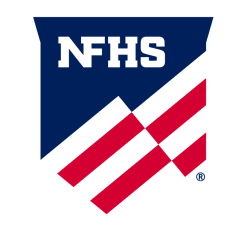The NFHS Voice

 The NFHS Voice
The NFHS Voice
Emergency Planning, AEDs Saving Lives in Nation’s High Schools
Dr. Karissa L. Niehoff, NFHS Executive Director
On January 2, millions of people held their collective breaths as Buffalo Bills’ defensive back Damar Hamlin dropped to the ground in a Monday Night Football game on national television.
A victim of cardiac arrest, medical professionals rushed to his aid to enact a well-thought-out Emergency Action Plan (EAP). Cardiopulmonary resuscitation (CPR) and an Automated External Defibrillator (AED) were utilized, and Hamlin was quickly taken by ambulance to an area hospital in Cincinnati.
While there were some tense moments in the days to follow, Hamlin recovered and continues to make progress toward a potential return to the NFL. The quick enactment of the EAP, along with CPR and use of the AED, saved Hamlin’s life.
We are pleased to share that there have been some equally heroic moments recently at the high school level.
In late January in Gatlinburg, Tennessee, a Gatlinburg-Pittman girls basketball player, Kendl Reagan, collapsed during a game against Union County High School. Like the more publicized pro football game, quick enactment of the EAP and use of an AED saved Reagan’s life.
Colton Jenkins of Covenant Health, who serves as the school’s athletic trainer, started CPR and activated the AED. Once Reagan was stabilized and her pulse regained, she was taken by helicopter to Children’s Hospital in Knoxville and has since been cleared by a cardiologist. Following the incident, Jenkins offered the following thoughts:
“Tomorrow is not promised, let alone how it is going to turn out. Always have a plan in place in case that ‘it can’t happen here’ scenario hits. When you have a plan, know your part and practice it. Never underestimate training and mental repetition, because if you have not mentally made up your mind that you will do a hard task like CPR, you might freeze when it becomes reality.”
In early February, one of the officials working the girls basketball game in Argyle, New York, between Argyle-Fort Edward High School and Whitehall High School collapsed on the court. Thanks to a visiting EMT from Whitehall, a nurse from Argyle and an AED located about 20 seconds away in the school hallway, the official’s life was saved.
Boyd Hunt, the Whitehall girls basketball coach, was the first to the referee’s side. Hunt helped with chest compressions before the AED was utilized.
“As much as people dread all the trainings that we do, that’s the reason we do this,” Hunt told Pete Tobey in an article in the Glens Falls (New York) Post-Star newspaper. “We all worked very coordinated to save his life. That’s what you’re hoping to do when you do the training.”
About this time a year ago, Ashley Cowan, athletic trainer at Bear Creek High School in Lakewood, Colorado, responded to a crisis. Near the end of the first quarter of a Bear Creek-Heritage girls basketball game, an official collapsed on the court due to a malfunction of his pacemaker.
Suddenly faced with a life-threatening situation, Cowan immediately rushed to the official’s aid as he gasped for air and his condition quickly worsened. With help from Jill Wapelhorsts, a Heritage parent who works as a respiratory therapist, Cowan instructed Bear Creek athletic director Zach Morris to call an ambulance and had a student run to get the school’s AED. After a shock was delivered, the pair continued to administer CPR until the official was once again alert and breathing. Another life was saved.
These case examples show that AEDs – in concert with CPR and implementation of a previously designed Emergency Action Plan – can save a person’s life.
The NFHS kick-started a nationwide effort several years ago to make sure every school has an AED. Through its NFHS Foundation, the NFHS distributed almost 1,200 units to schools and state association offices in 2018 and 2019. Since then, schools have ordered more than 1,000 additional units from the distributor.
Schools must have an AED – preferably more than one unit – in high-traffic areas and near athletic competition. Every school needs to have a working AED on the property – and staff members need to be trained in use of the machine.
However, the first step is to establish – and regularly practice – an Emergency Action Plan. The best-case scenario is for a school to employ a certified athletic trainer to establish and carry out the EAP. In some settings, this task may fall to a coach, athletic administrator or other school personnel. Following are some resources from the NFHS to help in implementing an EAP:
School administrators, athletic directors, coaches, parents and students should also be made aware of the following resources from the National Athletic Trainer’s Association (NATA) and the Korey Stringer Institute (KSI):NFHS High School Today Article (January 2022) – “Emergency Action Plans: Practice Makes Perfect”Anyone Can Save a Life – Emergency Action Planning Program
NFHS “The Collapsed Athlete” Online Course from NFHSLearn
NATA Position Statement: “Emergency Planning in Athletics”
KSI: “Emergency Action Plans”
Throughout its 103-year history, minimizing the risk of injury in high school sports and activities has been one of the most important roles of the NFHS. With more than 7.6 million participants in high school sports, we know that injuries will occur; however, we also know that lives can be saved if plans are in place to handle times of crisis.
Dr. Karissa L. Niehoff is in her seventh year as chief executive officer of the National Federation of State High School Associations (NFHS) in Indianapolis, Indiana. She is the first female to head the national leadership organization for high school athletics and performing arts activities and the sixth full-time executive director of the NFHS. She previously was executive director of the Connecticut Association of Schools-Connecticut Interscholastic Athletic Conference for seven years.









